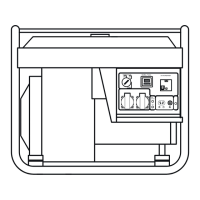
Do you have a question about the ITC Power GG4100L and is the answer not in the manual?
| Voltage | 230V |
|---|---|
| Frequency | 50 Hz |
| Displacement | 212 cc |
| Fuel Tank Capacity | 15 L |
| Starting System | Recoil Start |
| Weight | 45 kg |
| Engine Type | 4-stroke, OHV |
| Outlet | 2 x 230V/16A |
Perform a visual inspection of the external and internal components.
The temperature range for the use of this equipment is between +5°C and +40°C.
All items must be cleaned regularly. Ensure all filters are replaced.
Warning about dangerous exhaust gases; never use in poorly ventilated areas.
Generator repairs must be performed by authorized and qualified personnel.
Store the generator in a well-ventilated area to prevent damage.
Warranty is void if described start/stop procedures are not followed.
Failure to follow procedures can lead to equipment damage.
Check screws and nuts that may loosen due to equipment vibration.
Good quality oil and fuel are essential for equipment operation.
Store in a dry place, protected from frost, and ensure equipment is dry.
Avoid flames/sparks when using or fueling; do not store near flammable materials.
Exhaust remains hot after shutdown; avoid touching and allow cooling before moving.
Never place the generator in an inclined or vertical position to prevent leaks/damage.
Always check oil and fuel levels and perform maintenance before each use.
Check engine oil level before operation and add oil if necessary.
Oil is drained before shipping; check and add oil to the correct level.
Identifies the main engine switch and digital display for monitoring.
Protects the generator and connected devices from overcurrent.
Provides AC power output at 230V.
Provides DC power output at 12V.
Indicates power status and protects DC circuits.
Connection point for grounding the generator for safety.
Features for monitoring generator status and initiating startup.
Safety device to prevent electrical overload.
Protection components and a specific type of socket connection.
Outlets for supplying 230V AC power to devices.
Grounding connection for electrical safety.
Protects the generator from excessive electrical load.
Controls and indicators for operating the generator.
Essential safety feature to prevent electrical faults.
Components for circuit protection and power connection.
Provides AC power output at different voltage levels.
Safety grounding point.
Safeguards the unit against overloads.
Monitoring indicators and a switch for power source selection.
Protects against electrical overloads.
Outlets for connecting electrical loads at different voltages.
Grounding connection for enhanced electrical safety.
Initiates the engine startup sequence.
Instructions on how to check the oil level and add oil correctly.
Step-by-step guide for properly connecting the battery cables to the generator.
Instructions on safely filling the fuel tank, including capacity guidelines.
Steps to prepare the generator before starting, including choke and switch settings.
Instructions on how to start the generator using the manual recoil starter mechanism.
Instructions on how to start the generator using the electric start system.
Steps to safely turn off and stop the generator.
Guidelines for changing the engine oil at specified intervals.
Instructions for maintaining the air filter for optimal engine performance.
Steps for inspecting, cleaning, and replacing the spark plug.
Addresses problems related to insufficient fuel and their solutions.
Addresses problems caused by low oil levels and their remedies.
Troubleshooting steps for a generator with a discharged battery.
Diagnosing and resolving issues where the carburetor fails to supply fuel.
Solutions for problems arising from faulty plug connections.
Guidance on diagnosing and replacing a damaged voltage regulator.